A new working hypothesis
English language (Für deutsche Sprachübersetzung – Hier klicken)
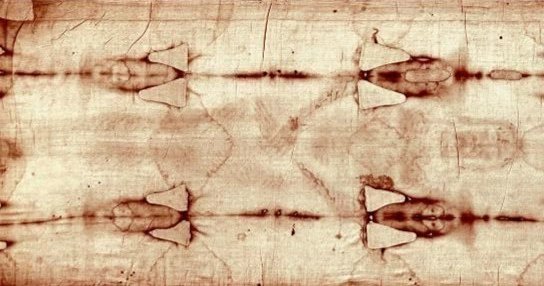
Hubert Allgäuer
© 2021, All rights reserved
Abstract
Ever since I first read about the Turin Shroud, I have been wondering how it could have come about.
With every report that I have read in the following time and with every documentation that I have viewed, I have thought again about it and tried to find a simple and meaningful answer to this question of the origin of the shroud.
Of course, as a sober and logical person, I was never able to believe in a supernatural possibility.
Therefore, I did not understand the belief hype surrounding this object and its worship by many believers.
By chance today I came across a possibility of origin (and rather not creation), of which I am convinced that this must apply based on the evidence presented below in the form of exact matches with a comparative object.
In no way do I want to belittle the faith of the readers of this work. My intention is only to find out whether – or to prove that – the creation of such an image is possible without any mysticism or technology.
Introduction
The ZDF-Documentation “Bares für Rares” with Horst Lichter
Today, October 5th, 2021 I have watched the broadcast “Bares für Rares” on ZDF.
Here is the link to this ZDF-Mediathek broadcast: Click me
In that broadcast a picture “Croatian with Chicken” created in 1929 by the artist Carl Moser was presented by 00:35, which was brought to the recording of this broadcast by its owner, Herbert Grimm from Herrieden (Germany)..
This picture was made on thin Japanese paper using Japanese multicolor woodcut-printing.
It was bought in that broadcast by the Austrian art and antiques dealer Wolfgang Pauritsch.
But this picture has already been resold in an auction to an unknown person / company.
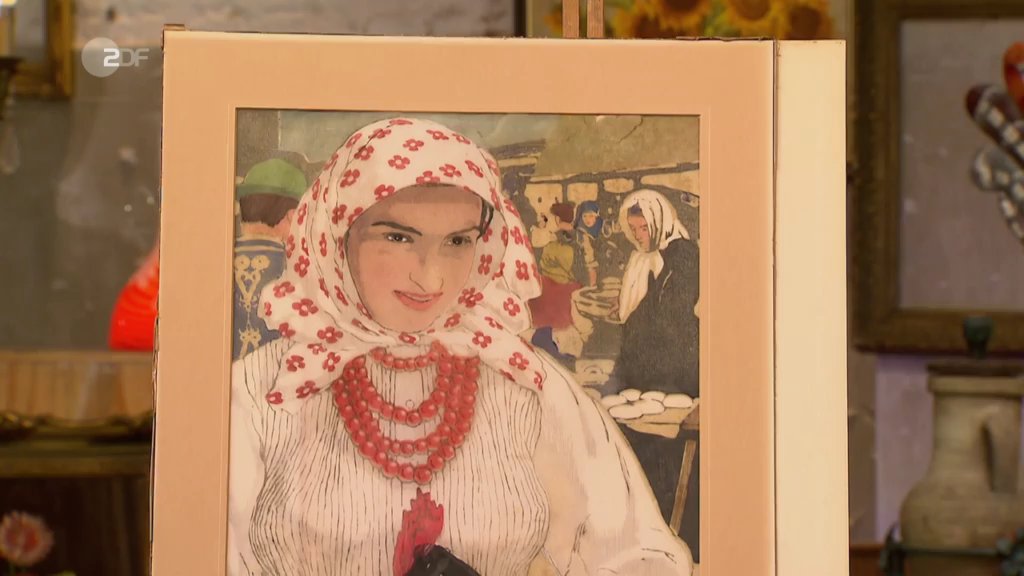
But after a short time I almost fell off my chair.
Because then the picture was removed from its base and the following appeared on its underground:
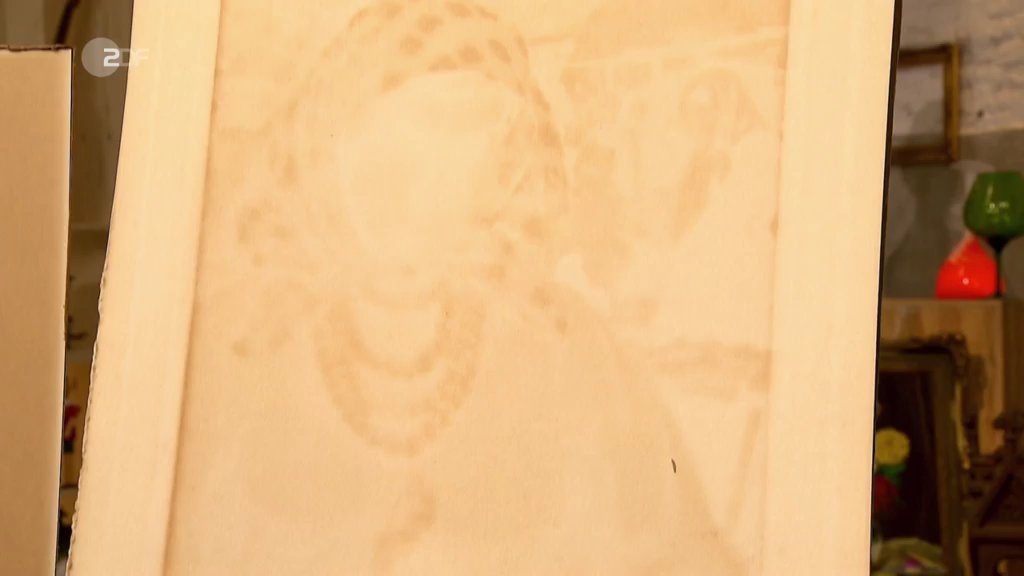
A black and white negative image of the original image appeared on the backplate of the image.
In other words, a second picture in the complementary colors of the original-image, if you were to convert it into a black and white grayscale image.
The picture behind the picture
Something stands out …
This is namely not a completely real or correct black and white negative image-reproduction.
If you look at the woman’s face, you can see that the dark eyes of the original picture stand out brightly on the backplate, while the lighter, skin-colored face is shown darker.
Just as you would expect on a negative image.
But you can also see that the dark, red color of the necklace and the flowers in the headscarf in the picture have left a dark mark on the background. Instead of the light color actually expected in a negative image in these areas.
While the black eyes of the woman and the black chicken can be seen in a real negative representation, i.e. in a very light color on the background.
How this picture behind the picture was made
One of the experts in this documentation, Colmar Schulte-Goltz, explained that the acid, what the Japan-paper contains, is supposed to be responsible for transferring the shadings from the picture to the background.
The closer the protective glass lies on the upper original image, the more the transfer to the background and thus produces the generation of the second “image”, he explains.
However, the expert Mr. Schulte-Goltz did not associate this “picture behind the picture” that he uncovered with the Turin shroud. Just like probably none of the viewers of this documentary.
Obviously, this is an reaction (oxidation) of the color caused by the acid in the drawing paper, which, as a kind of “acid burn”, only decomposes the uppermost layers of the background and therefor does not interact with deeper tissue.
This reaction also explain the false negative color change that exists in some colors.
This occurs when certain light colors in the original-picture simply do not react or react only slightly with the acid, or when used certain dark colors react strongly with the acid.
With these light colors, there is either no or only a slight oxidation on the background and these areas remain almost in the original color of the background.
Or, in the case of dark colors in the original-picture, violent oxidation takes place, which creates a color that is just as dark on the background as the color used in the positive original image due to the strong interaction through the decomposition of the uppermost layers concerned.
So it is also, or rather mainly, the composition of the color that has been used, how strong the acid reaction turns out to be on the background, and how dark the acid-burned areas behind these colors are created as a result.
Since the background is chemically attacked and decomposed, the resulting image is permanent like a tattoo and also waterproof and cannot be removed, as would be possible if the color was applied.
So it is very plausible that the expert explains that acidic action created the negative image on the background.
This then leads to the fact that different colors produce either a real negative color (as in the picture with black and white picture color) or a similarly dark color (like the dark red in the picture) on the background.
Findings
This unintentionally created image behind an image illustrates how an almost correct negative image can created that contains absolutely no color pigments. But it is still clearly recognizable on the picture (or actually on the background).
This picture also proves that the effect that has occurred here does not transform every original color into its black / white negative complementary.
(This statements are important for the comparison to the Turin Shroud described below.)
It should be noted that the originally painted colors of the original image are mainly reflected in their correct and reversible black / white complementary colors on the background material due to this oxidation. With a few colors, however, the expected back-calculable transfers in complementary black / white color tones do not result.
The semitransparent Japanese paper used for the original color image or the high acid content in this is to be classified as a relevant element of this transformation of the image information from the image on its carrier plate.
In any case, it is not the color that diffuses through the Japanese paper onto the background but oxidative acid burn marks …
Therefore, surely no color pigments can be found on this negative image.
The Shroud of Turin
As can be seen in the corresponding Wikipedia article, the Turin shroud shows also not a “real” negative image.
At this point I can’t help but swipe – the authors who on the above-mentioned Wikipedia articles having their hands on it (deciding which information will be included in this article and which will not) do not even want to allow this simple statement in this article that the Shroud actually shows a negative representation of a person. Although almost all scientists take this point of view …
annotation
In the following, for easier understanding, the original image on the shroud is referred to as “negative” because it shows a negative image of a person.
Technically speaking, however, the shroud is a positive, as it is currently assumed that it is an original (originals are always referred to as positive) and not a negative copy of an unknown original.
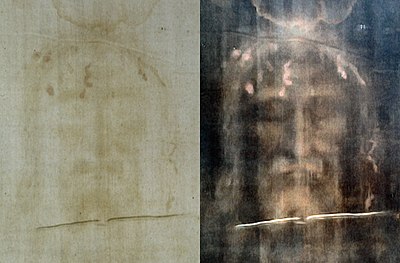
With his 35 years of age and his origins, Jesus certainly had no white hair and beard. He was also guaranteed not to be blonde, much more likely to have dark brown or black hair – which, however, should be shown in exactly the same color in the positive image – but not are.
There is no question that the population of ancient Israel had black hair throughout.
For example, there is a passage in the Bible in 3. Book of Moses (Leviticus), Chapter 13, Verse 31, which only allows the conclusion that the hair of all Israelites was black at that time.
According to the research results, the shroud also does not contain any color pigments.
And with some of the colors that are necessarily present in an positive original image or the real figure of Jesus Christ, it does not show their correct negative correspondence.
In order not to inflate this article unnecessarily, interested parties who are looking for further information on the Turin Shroud are referred to the Internet with its diverse research options.
Because for the thesis, which is represented here, no further information on the shroud is required.
Conclusions
The comparison of the two pictures, i.e. the negative picture by the artist Moser, which was accidentally created on the background of his picture, and the Turin shroud shows the following similarities:
1. Wrong colors
With its properties, the shroud corresponds to the identical creation of the negative Moser image on its background as described above.
The shroud is also not a “perfect” negative image.
Just like the picture shown above by the artist Moser, which was accidentally created on the underground.
From this it can be concluded that in the case of the shroud, the color used for the dark hair color, which the artist must have used for his original picture of Jesus Christ, actually reacted very strongly with the acid in the paper used. And that these areas therefore show the dark traces of strong decomposition on the substrate, i.e. on the strip of material with the negative image.
Which are shown then as white hair in the digitally converted positive image.
No scientist or artist who has tried to recreate the production of the shroud has yet succeeded in incorporating such false colors into his work with simple means.
With the Effect described here, however, these color errors appear on the background by themselves. And this easy and without the need of using complicated or modern practices.
Rather, it is solely due to the unintentional or targeted selection of the colors used in the positive original image and the resulting weak or severe decomposition of the material of the image background.
2. No color pigments present
On neither of the two pictures, i.e. the coincidentally created background picture by the artist Moser, nor on the shroud, there are even the smallest particles of color with which the images could have been created.
Rather, the “color” of the images is acid burns of the background material, which in both cases was responsible for the generation of the images.
3. No contur lines
There are also no contour lines whatsoever in either of the negative pictures, which are absolutely necessary for the creation of a work of this kind.
No wonder – the contour lines, which were mostly drawn with pencil or charcoal on the original images and which can usually also be detected under the color by means of X-ray examinations, are in this case also on the original image and are not affected by the action of acid on the underlying material transferred with the negative representation.
4. Images created by “scorching”.
In the course of the STURP (research project Turin Shroud) investigation of the shroud at the end of the 1970s, the scientist Barrie Schwortz (STURP documentation photographer) involved in the television documentary “The Shroud of Turin” (15:50) expressed the scientists’ assumption that the picture on the Turin shroud could be scorched, as its color is most reminiscent of the brown prints on ironing boards.
Their investigations showed that the fire damage from 1532 caused by the real combustion in the fire and the image under normal lighting look about the same. But if you irradiate the cloth with UV light and then take a photo, you only see the fluorescent scorching traces of the fire, but no more the image of the body.
So normal exposure to heat can be ruled out.
Although, this research group considered a probable heat exposure as the cause of the image.
But the conclusion of a possible acid effect through the reaction of the acid in the original painting paper and the color on an original picture that was then on the shroud (and has since been lost) did not occur to the scientists at the time.
At least these scientists came closer to the core with their assumption about the origin of the shroud than any other scientist before and after them.
The negative image of Moser was also evidently caused by “scorching” – but by acid and not by heat.
5. “Colors” through chemical change
Another scientist, the chemist Dr. Ray Rogers, who was the director of the STURP-Project, explained that various instrumental research results suggest that the color variations of the fibers are due to a chemical change and indicate a slight combustion or an oxidation with hydrogen elimination.
So the shroud or the image on it was definitely created through oxidation too.
However, the scientists could not explain the cause and the way in which the shroud was made.
6. Waterproof “colors”
In the case of the shroud, too, it was found that the attempts to extinguish the fire in 1532, in which the shroud was extinguished with water and / or wine, had no effect on the representation on the shroud.
The representation can still be seen undisturbed, even under the water spots.
Each type of conventionally used color should have interacted with water or other liquids, which could be detected in the form of bleeding colors or color changes.
As a result, it can also be assumed with the Shroud that it was not color but rather acid that produced the image, which corroded the top layers of the fabric and is therefore permanently visible.
Logical consequence
Due to these matches, it can be assumed that the Turin Shroud must have been created exactly like the background image in the documentation described above.
Namely, by the unknown artist (or rather, the alleged forger) who painted a picture in a positive representation on the thinnest Japanese paper.
This picture was placed or mounted on the length of fabric by him or a third party.
Over time, the negative image that we know today as the “Turin Shroud” emerged by itself on this length of fabric.
It is actually more necessary to speak of an effect or an impact than of a technology used that led to the creation of the shroud.
So unfortunately there is no real Jesus on the Turin shroud, but only an acid reaction in the form of oxidation of a picture, which is painted on a kind of Japanese paper (on a very thin, almost transparent and acidic paper) and was placed on the Panel.
All that is needed to manufacture such an Image is a thin and permeable, but acidic painting paper (like Japan paper), which is placed on the cloth. Then you paint a painting on it with conventional and very common colors and wait.
Time does the rest and by means of oxidation, through the reaction of this chemical burn on the outermost layers of the fabric, it creates an almost correct black and white negative image of the image previously painted on the painting paper.
With a few false colors in it and without any color pigments on the fabric.
Japanese paper was invented more than 1,300 years ago. This paper was also known in Europe in the 13th or 14th century, and it was relatively easy to get this paper.
Even though it wasn’t really cheap to buy at the time, either.
This is how the Shroud of Turin was created, quite unmysterical, but also without particularly or difficult techniques – rather without using any techniques.
It was simply either a chance discovery by an artist, which the artist had taken to extremes in one of his subsequent works,
Or it was a chance find that only showed up after the original image had been removed from the fabric. And maybe even long after the artist died and he knew nothing about the creation.
It is extremely noticeable that some color tones are clearly shown in the positive images, which are digital converted from the two “negative” images, in a strikingly light color which, however, should be dark in the positive.
Which supports my explanations that both images must be built with the same production effect.
On the one hand the dark red pearl necklace and the floral decoration in the headscarf on the original Moser picture, which also appear dark in the negative background.
On the other hand, the actually dark hair of the real Jesus Christ, which is also shown dark in the negative on the Turin shroud.
All of these colors should appear light in the negative, but are shown dark there.
Which in the digital positive conversion results in light false colors instead of correctly dark colors.
The blood-prints
At some point the shroud was “embellished”, not to say “dramatized”, by applying human blood or corresponding paint to it.
However, the bright blood stains on the in the digital positive conversion of the shroud play a special role.
These appear – although they are very dark in reality – in the negative representation only for the reason consequently in dark color(and bright in the digital calculated positive image) because they were first applied in dark and perhaps as real blood directly to the negative representation on the cloth, on which they also appear dark correctly.
An introductory positive-negative conversion did not even take place with these spots. Otherwise, they must be shown bright in the negative view on the shroud.
This application of the blood can therefore only have happened at a time when the image on the fabric was already visible and was probably already worshiped.
In contrast to the other colors caused by chemical burns, which only attacked the surface of the fabric, the blood or the color used for it, as it was applied directly to the fabric, could also penetrate deep into the fabric and came across it.
Therefore, the results of the chemical investigation of these stains suggest that this is supposed to be real human blood on the shroud, speaks not even against the thesis presented here.
Since the dark blood color was applied directly to the negative image, its spots are therefore also visible in the negative image as dark instead of light as expected (and visible in the resulting positive image as light instead of dark). Which proves that these spots could not be applied to the original image, but were only applied later to the finished negative on the cloth.
It is also quite conceivable that for this effect- and belief-reinforcement by means of the blood subsequently applied to the grave shroud, even a suitably prepared person (i.e. with blood or color at the correlating points of their body decorated) was placed in correct position on the shroud with the image. This cloth was then folded over the person so that the cloth covered the front and back of the person.
An anatomically very correct blood / color distribution on the shroud could thus be generated with great certainty.
The footprint
On the part that shows the back of the person, there is a “bloody” footprint below the legs – just like when a person decorated with blood has to stand on this part of the cloth in order to lie down on their backs.
This person (supported by two helpers who hold their hands) inevitably rolls backwards over the heel placed on the cloth, the foot no longer changes its position in the further course. Exactly as the representation on the shroud shows, anatomically correct.
But if a corpse was placed on the cloth by a third party, there would certainly be no footprint of this dead person expected at this point.
If one put the person with angled legs on the cloth and then outstretched their legs, this footprint would have to be further towards the buttocks.
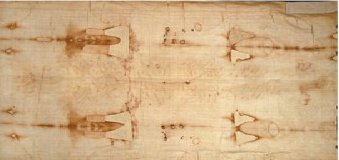
This is shown enlarged in the following picture
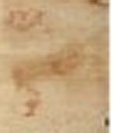
The reason is simple – if a body were to lie on the cloth with its legs drawn up in such a way that the soles of the feet completely covered the cloth to leave such a footprint, the person would be around 8 to 10 inches taller than their lying dimensions. Since the footprint of the person on the cloth is already about 5 foot 8.5 inch to 5 foot 9.3 inch (other sources talks about up to 5 foot 10.8 inch) long, this would result in an actual body size of 6 foot 6.3 inch to 6 foot 7.15 inch.
But 2000 years ago, the average size of humans was only between 4 foot 11 inches and 5 foot 3 inches.
If Jesus were 9.8 inch to 1 foot 1.77 inch greater than his fellow citizens, this circumstance would have been called certainly in the Bible.
In addition, Judas would certainly not have to identify Jesus against the Romans through a kiss if Jesus was actually 1 foot greater than all the people accompanying him.
Further research
The following investigations should answer what was ultimately responsible for the effect, I have described here.
Also, must be clarified through further scientific studies:
- Whether the acid of paint
- And / or the acid in the Japan paper,
- The interaction with the color spectrum of the sun
- Or other influences such as the refraction / transmission behavior of the protective glass in front of the picture or even the window glass in the room in combination with the color spectrum of the sunlight acting on the original picture
have played a role in the question of how the “negative” image behind the Moser-Picture was created on its background, and why the dark red color in the image of Moser produced a “non-negative” dark color transfer to the background.
The “how” of the creation of the shroud is already explained now by the “that”, i.e. the existence of the negative comparison image, the method of production of which is sufficiently known by the drawing of the Artist Moser.
Since the comparison Moser image was created due to explainable oxidation, this must also be assumed for the Turin shroud.
In the future, it will be only necessary to determine the exact cause of the oxidation and the conditions that led to it need to be researched.
But now it is at least clear at what point the researchers have to start in order to answer the last open questions of the Myst of the Shroud of Turin.
In the following experiments to reproduce the shroud, the type of production of the original picture must then probably also be taken into account. Because the colors used must not be on top of each other, but should be applied next to each other on the image if the result is to be a negative image that is easily recognizable on the background.
This was achieved in the above picture by the artist Moser through the special Japanese woodcut printing technique, in which each printing plate used only uses one color.
As a result, it is almost nowhere that colors are printed on top of other colors.
Because only in this way is the negative image likely to be quite recognizable in the end.
Without the different acid activities of the different overlapping colors being mixed and thus showing the same pH acid value everywhere on the negative and thus the same color being visible everywhere. Otherwise, the negative image would no longer be recognizable.
It would also be useful to investigate whether the image shown above has been exposed to direct sunlight for a period of time (or quite a long time). Whereby, perhaps the light and UV radiation could have contributed to creating the negative image on the image background.
Dense colors, little light transmission – bright reproduction on the background.
Translucent colors, a lot of light transmission – dark reproduction on the background.
The spectral composition of our sunlight would then perhaps contribute to the “false colors” in the negative image when using certain color tones.
Here, the dark red in the original positive image wrongly turned into a dark color in the negative image.
Which ultimately leads to the fact that the positive image converted digitally from this negative image, originally dark red, is reproduced as light and not as dark.
Hypotheses on the origin of the shroud
There are two logically conceivable possibilities that can be expected with human action, which led to the creation of the Turin Shroud:
1. The intended creation
In the course of his work, the artist accidentally came across this effect, that a picture he had painted on Japanese paper had transferred in a strange way and puzzling color scheme to the background of the picture he had painted.
At that time, these abnormal colors of the secondary image that appeared inexplicably on the base of his pictorial work, with its color negation, must have had an almost uncanny effect on the artist.
Almost like a ghostly copy of his work attached to the base.
The artist must have recognized that the effect that occurred could not come about through normal color that was printed through the drawing paper.
But even as an artist experienced in the use of color and probably also trained in color theory, he was unable to explain the creation of the negative image with its strange color composition on the painting backplate of his picture in his day.
After all, negative images were not developed until the end of the 19th and beginning of the 20th century, when photography was invented.
In the 13th or 14th century, the artist certainly never heard of complementary colors also.
So he recognized the resemblance to the original he had painted, but not how it got onto the back of his picture.
It must have seemed to him that higher powers were involved.
This miraculous creation of the picture on the base may have amazed the artist so much that he replicated this effect with a picture of Jesus painted by him on Japanese paper on a piece of fabric as a base.
And what would be better suited to depicting the mystery of Jesus Christ than a picture created by magic hand and without your own intervention on a previously empty background of a picture?
So the artist repeated this effect and painted a corresponding picture of how he imagined Jesus Christ lying on the shroud on a long sheet of Japan paper, which he had mounted on a panel of fabric.
And after a while, the negative image we all knew appeared on this material.
Another possibility for the creation of the Turin Shroud would be much more profane:
The artist painted his picture quite normally (and maybe even as a commissioned picture) on Japan paper, which, in order to stabilize it and to be able to paint on it, was mounted on a panel of fabric.
And after a while, the negative image we all knew appeared on this material.
2. Unplanned and accidental emergence
Another possibility for the creation of the Turin Shroud would be much more profane:
The artist painted his picture quite normally (and maybe even as a commissioned picture) on Japanese paper, which was mounted on a panel of fabric in order to stabilize it and to be able to paint on it.
In the course of time the Japan paper decomposed and with it the painting on it or was removed from the fabric and was lost at some point.
Or perhaps the artist just gave the client the long sheet of Japanese paper that he had painted after completing the original image and kept the working document himself – on which the negative image of his painting appeared.
Without further ado, what we know today remained: a length of fabric with an almost correct negative image on its surface – the Turin shroud.
In this case, the artist would probably not have experienced the creation or its discovery of the negative image and would have died long ago by this point in time.
In fact, an intention to deceive would not even be recognizable here.
At most the misinterpretation of a very banal physical process – the oxidation -, which continues to this day.
Supplementary comparisons
Here again the pictures in direct comparison – left original and unretouched
Unfortunately, due to the poor quality of the image material available to me, the details of the following images can only be recognized on a largest possible, high-resolution, high-quality and correctly adjusted monitor.
Any activated night light mode on the monitor must be deactivated in order to recognize the following images – the screen colors must be displayed correctly.
Primary, it should be noted that the picture by the artist Moser shown here is unfortunately only a lower quality screenshot from the video documentation.
If a good photograph of the negative image were available, the negative and positive images of the Moser image shown above would be much more detailed, better illuminated and thus even more meaningful.
But you can still see that the two objects were created in the same way.
The Moser image
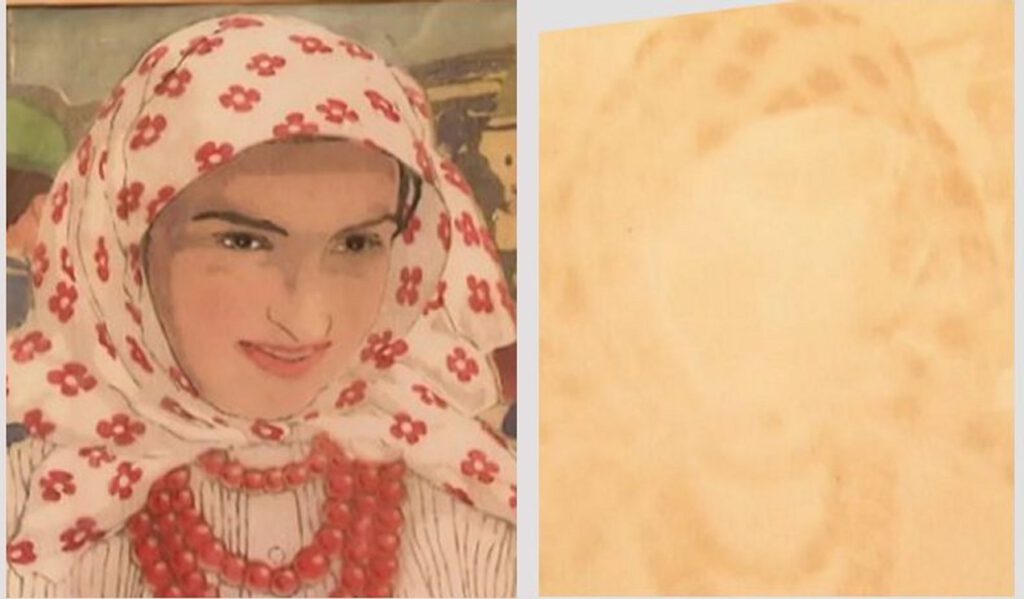
Negative images (original):
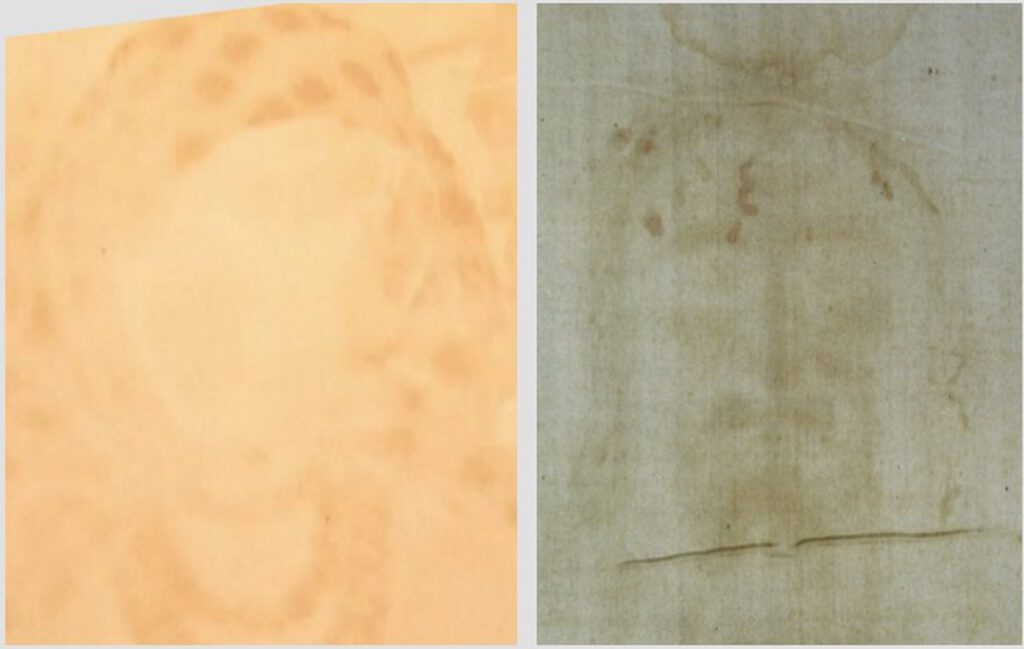
Digital converted positive image from the nagative images above
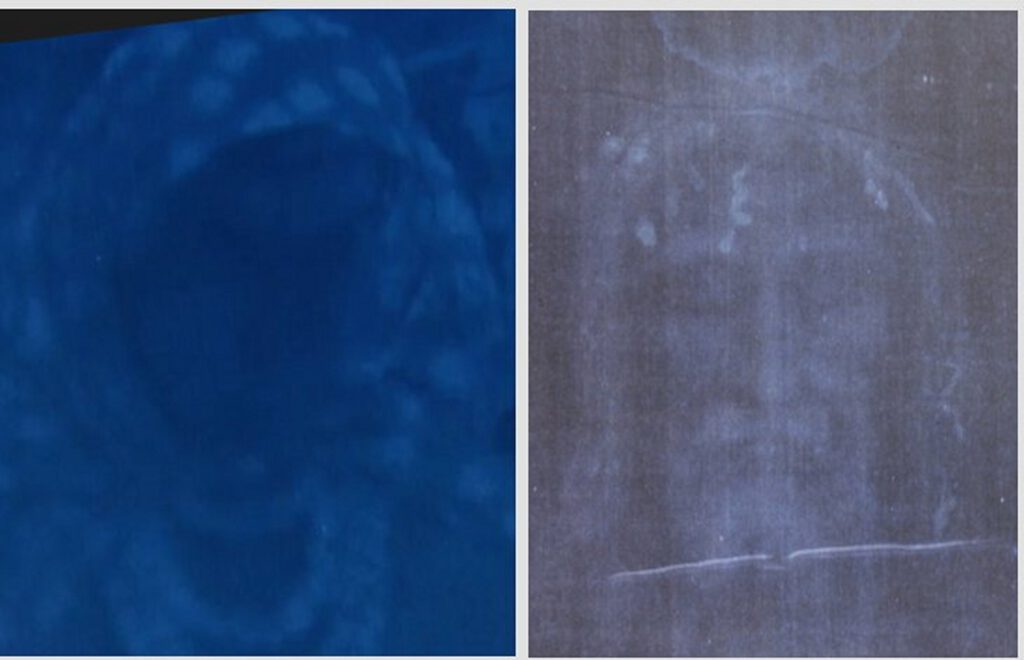
The two pictures (the unintentionally created picture by the artist Moser on the picture carrier and the Turin shroud) were evidently created in exactly the same way and with identical technology.
The blue color of the digitally created positive of the Moser picture is only due to the complementary color of the yellowish background of the picture with the negative representation. If the color of the background of the Moser picture were identical to that of the fabric of the grave cloth, the two positive pictures would be even more similar.
In the following image, an attempt was made to compensate for this by first translating the background negative image into grayscale and then converting it into positive. Unfortunately, detailed information is lost here – this demonstration is only about the identical effect that this image creates.
The result:
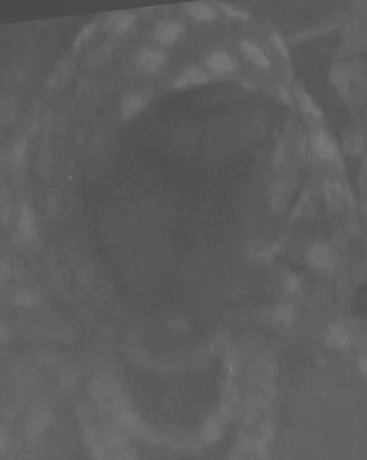
Although the intention of the painter, Moser was not based on the creation of a real-looking image, but rather the picture behind the picture was created completely unintentionally.
The rather flat-looking negative-image from the background of Moser appears much more vivid on the digital positive image obtained from the negative image of the background than on its original image.
Exactly as the digitally created positive image of the shroud.
While the artist who created the Turin Shroud, perhaps after discovering this effect in the run-up to the creation of the Shroud, could have experimented quite extensively with his colors and their effect on the transfer to the background.
And the Shroud eventually is the final result as a highlighted end product of his labors.
Remarks
What do you think of the connection between the striking similarities and the obvious “color” errors?
Please feel free to send your thoughts on these conclusions via form message to the author.
Unfortunately the author is not personally aware of any researchers, artists or other persons who could verify and prove the thesis that is described here.
The author would therefore be very happy if scientifically organized researchers would use this description to test the information presented here on models they created in order to finally create clarity with regard to the origin of the shroud.
In this case, too, the author asks those to use form message to share their results of the experiments with him.
It would be nice if this could explain the mystery of the Turin Shroud finally.
Author: Hubert Allgäuer
Sources used:
ZDF broadcast on October 5th, 2021 “Bares for Rares“
STURP-Project Website
Documentation “Turiner Grabtuch“
Documentation “ The Shroud of Turin “
Documentation “Das Turiner Grabtuch”